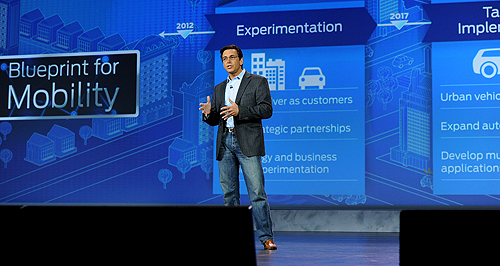Make / Model Search
News - FordOutback safety challenge issued by FordFar Fields: Ford president Mark Fields announces the 25 mobility experiments and challenges at the Consumer Electronics Show in Las Vegas. Ford looks to technology buffs to help improve safety of drivers in remote areas7 Jan 2015 KEEPING drivers safe on Australia’s Outback roads is the subject of one of 25 mobility technology experiments around the world announced by Ford Motor Company at this week’s Consumer Electronics Show (CES) in Las Vegas. Called Ford Smart Mobility, the program of experiments and challenges is designed to take the Blue Oval brand to the next level in connectivity, mobility, autonomous vehicles and other hi-tech technologies. The Australian challenge – one of 11 designed to address specific issues in North America, South America, Portugal, Africa, India, China, England and Australia – is expected to be detailed in full in the next few days. However, Ford has already announced that “innovators” will be asked to come up with a car accessory or phone app to address the challenges of driving in remote areas of Australia, “the country with the third lowest population density in the world”. In the blurb accompanying the challenge announcement, Ford says: “Drivers travelling in remote areas over rugged terrain must be prepared for emergency situations and conditions. “Having access to help and resources is one of the challenges they face during their journey. A long drive in a desolate location may also lead to driver distraction and inattention. “Ford is asking innovators to invent a novel accessory or app that increases driver awareness in remote regions or over rugged terrain. “The main goal is to enhance driver self-sufficiency in difficult situations, like electrical failure, hazardous weather and dangerous road conditions.” Ford president Mark Fields said the company wanted to change the way the world moves “just as our founder Henry Ford did 111 years ago”. He said that while Ford was showcasing connected cars at the CES and announcing plans for autonomous vehicles, the experiments and challenges had a higher purpose. “We are driving innovation in every part of our business to be both a product and a mobility company,” he said. Mr Fields said the experiments would address “four global megatrends” – explosive population growth, an expanding middle class, air quality and public health concerns and changing customer attitudes and priorities. “The experiments we’re undertaking today will lead to an all-new model of transportation and mobility with the next 10 years and beyond,” he said. In one experiment in the United States, the car’s parking sensors can detect parking spots while driving along and then upload the information to the cloud for the benefit of other drivers searching for a parking spot in the area. In London and New York, a fleet of mini buses is trialling pick-up and drop off on demand, with customers using phone apps to enter their location and destination. The route of the bus is automatically selected to suit up to 10 passengers. On a more pragmatic note, Ford also unveiled the third generation of its SYNC communications and entertainment system that it says will begin arriving in its new vehicles this year. SYNC 3 is said to have more conversational speech recognition technology, a more smartphone-like touch screen and easier-to-read graphics.  Read more |
Click to shareFord articlesResearch Ford Motor industry news |











Facebook Twitter Instagram